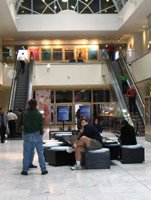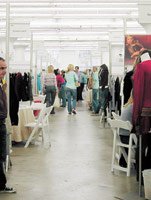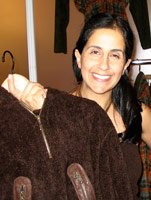L.A. Market to Come Early for Spring '06
Split Fall ’05 Market Frustrates Reps and Buyers
Los Angeles Market Week will step onto the international stage when the Spring 2006 shows collectively run Oct. 21–25, two weeks earlier than originally scheduled, in a move to attract more foreign retailers and exhibitors and alleviate the schedules of manufacturers who produce overseas.
The decision came a day after the close of the Fall 2005 Los Angeles Contemporary Market, which, along with the Brighte Companies and Designers & Agents trade shows, was separated by a span of three weeks from the Los Angeles Fashion Market and the Los Angeles Majors Market, which will take place in April. The experiment to halve the markets angered many exhibitors who devoted time and money to an event where business flopped. It also frustrated out-oftown retailers who did not desire to return to Los Angeles a few weeks later.
“We’re very pleased and happy [about the development],” said Ed Mandelbaum, who co-produces New York–based D&A and, along with influential showroom owners such as 10 Eleven’s Betsee Isenberg, has been a staunch advocate of earlier dates. He said international buyers stop making purchases by late March and late October.
The last organization to agree to the earlier dates was the California Market Center, which was recently acquired by Jamison Properties Inc. John Kim, the building’s new general manager, said that “having a consolidated market seems to make more sense than having two markets.” (Escrow on the CMC is expected to close by the end of the month.)
The news should appease showroom owners who waited in vain for buyers during the March 17–22 run of market. “It was half the market, and we got half of the attendance,” said Liza Stewart, president of Liza Stewart Inc. in the CMC.
At Leila Ross Sales in The New Mart, traffic was “definitely slower” because of the split market and the high airfares brought about by schools’ spring break vacations, said account executive Amber Bessy.
Mandelbaum’s decision to start D&A on March 18 resulted in a 7 percent decrease in attendance to 1,717 visitors. He admitted that he had been bracing for a decline of as much as 35 percent. There were 229 booths and 352 collections, up from 178 booths and 303 collections one year ago.
Isenberg—who represents James Perse, Diane von Furstenberg and other hot contemporary labels at 10 Eleven—said moving up the dates will benefit manufacturers that use European materials and offshore production. Many are hard-pressed to take orders in April for deliveries in July, she said. Plus, she added, the new dates will let Los Angeles shake off the image of being a regional industry. Despite holding its own fashion week, Los Angeles starts its market week after the trade shows in Dallas, Chicago and Atlanta, she said.
Isenberg said her business was off during the contemporary market and that she will not open her showroom for the April 9–10 weekend of Los Angeles Fashion Market. “This, to me, was my market week,” she said, adding that the earlier dates will be attractive to buyers traveling from as far as the United Kingdom, France, Germany and Asia. “They love California fashion.”
Split decisions
For buyers such as Jorja Gaskins, the split market was confusing and an inefficient use of time. Gaskins, who traveled from San Francisco to scout new lines at D&A for her eponymous shop, purchased sexy fitted camisoles and wraps made in cashmere by Cris. But she said she will not return in early April for the market’s second installment.
At the CMC, which hosted Brighte in its fashion theater, 64 percent of attendees came from California, and the rest hailed from other Western states, Canada and Japan, reported Cecil Strickland, the center’s executive director of retail. Retailers—ranging from Seattle-based Nordstrom Inc. to Los Angeles–based Lisa Kline and Kitson—walked the CMC’s halls searching for the best in contemporary clothes.
To accommodate the split markets, Brighte launched one show on March 18 and plans to start another on April 8.
Jeffrey Schwager, owner of a New York showroom bearing his name, estimated that it cost $5,000 per line to participate in Brighte. He said the money may not be recouped because he will spend a similar amount to participate in Brighte in April.
“This show was not terrible,” Schwager said. “It was not unworthwhile. It’s just too bad I’ll have to come again.”
Elyse Kroll, president of ENK International, the New York–based producer of Brighte, estimated that attendance was one-third lower than that of a typical Brighte event. The recent show provided exhibition space for 120 designers. Brighte typically hosts 70 to 150 vendors.
Some buyers at Brighte did not mind the bifurcated schedule. Annet Badal, the knits buyer for San Diego–based young contemporary chain Rampage, said it was convenient to drive to Los Angeles. Shauna Stein, co-owner of Los Angeles specialty boutique On Sunset, said she purchased European lines such as London’s Buddhist Punk and Italy’s Transit at D&A, Brighte and the CMC.
Stein said she was concerned that the general fashion market had stressed embellishments and bohemian/ethnic looks for too long. “It’s not going to give my client a good enough reason to buy,” she said.
Still, at Louis Verdad’s booth at D&A, retailers snapped up a brown mid-length coat that had a dot appliqueacute; matching a wide embossed leather belt ($619 wholesale), said Claudine Covolo, a consultant handling Verdad’s sales. The booth was busy on the last day, when many of the big accounts, including Jennifer Croll, came, she said.
























